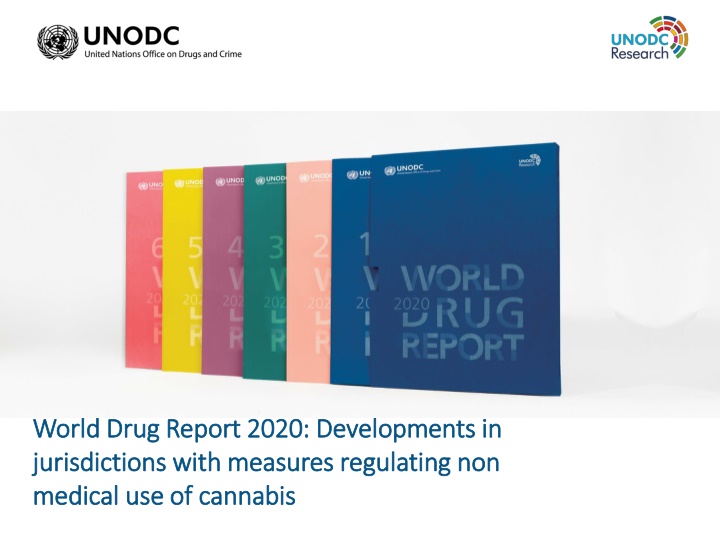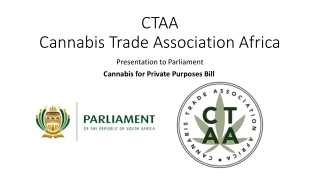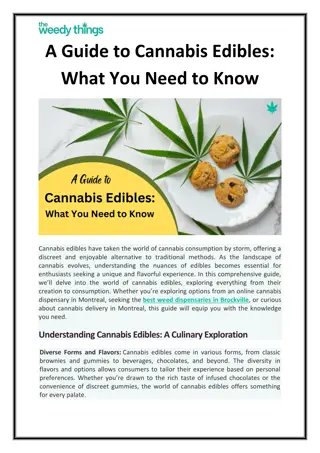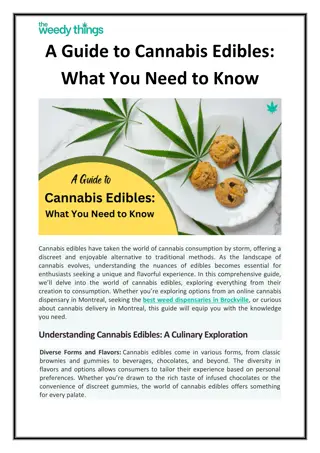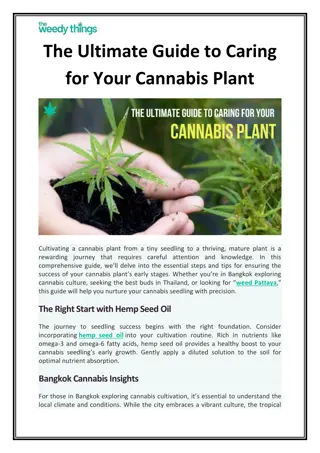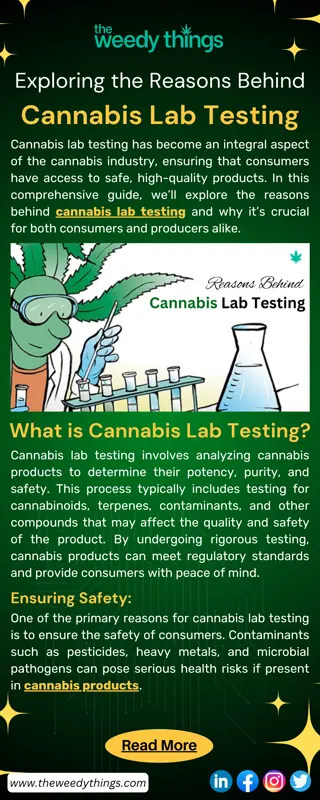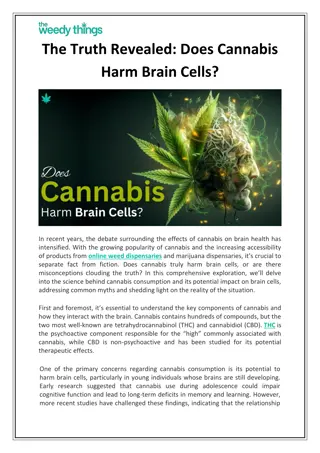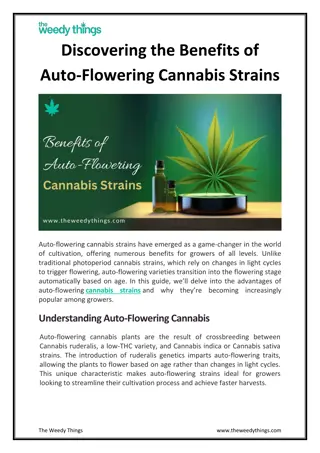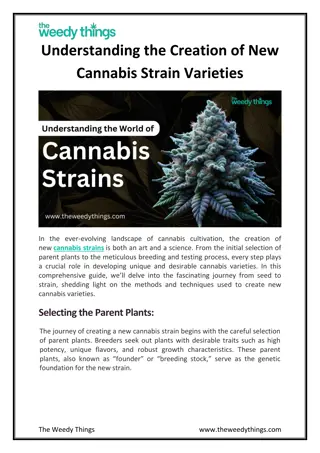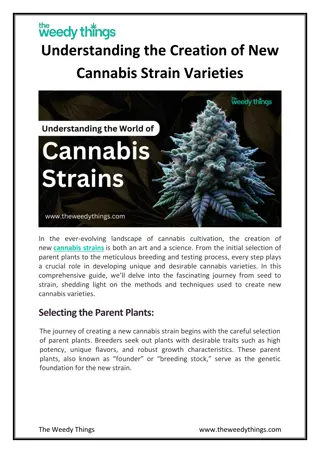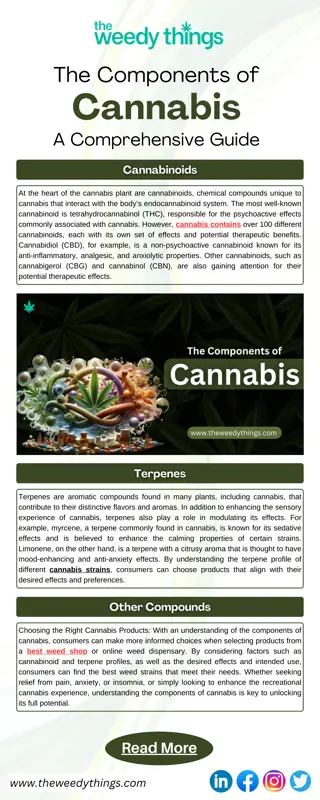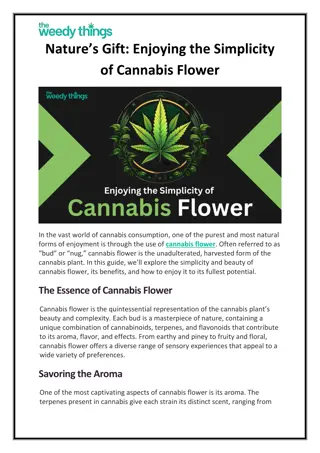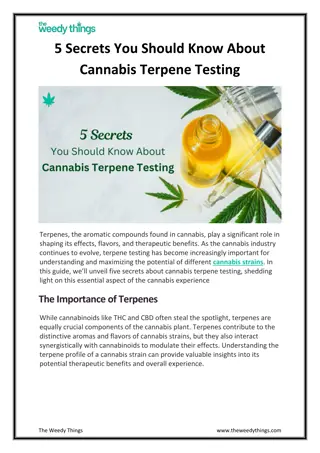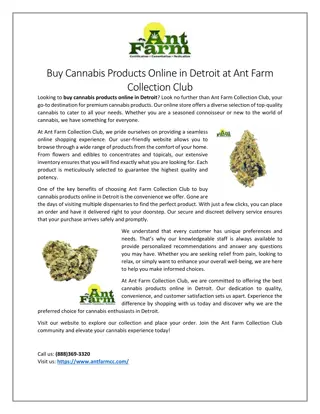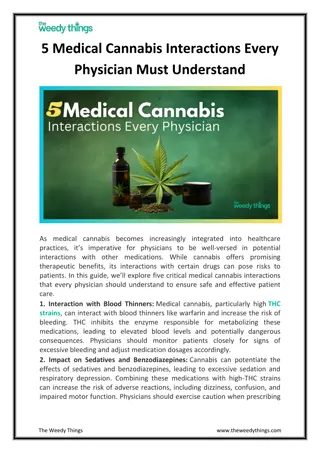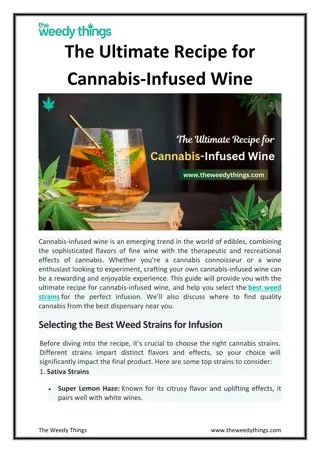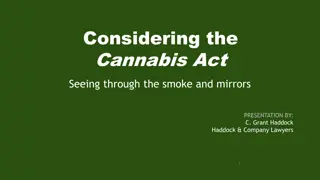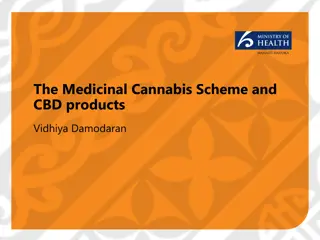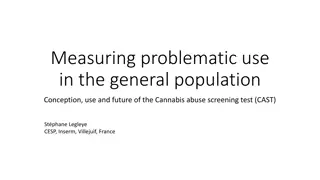Developments in Legalization of Non-Medical Cannabis Use: Canada's Progress
Legal provisions allowing non-medical use of cannabis have been approved in Canada and other jurisdictions. The Cannabis Act permits commercial production and sale of cannabis products for non-medical use while focusing on public health and safety.
Download Presentation

Please find below an Image/Link to download the presentation.
The content on the website is provided AS IS for your information and personal use only. It may not be sold, licensed, or shared on other websites without obtaining consent from the author.If you encounter any issues during the download, it is possible that the publisher has removed the file from their server.
You are allowed to download the files provided on this website for personal or commercial use, subject to the condition that they are used lawfully. All files are the property of their respective owners.
The content on the website is provided AS IS for your information and personal use only. It may not be sold, licensed, or shared on other websites without obtaining consent from the author.
E N D
Presentation Transcript
Click to edit Master text styles Second level Third level Fourth level Fifth level World Drug Report 2020: World Drug Report 2020: Developments in jurisdictions with measures regulating non jurisdictions with measures regulating non medical use of cannabis medical use of cannabis Developments in
Developments in jurisdictions with measures regulating non medical use of cannabis As at December 2019, legal provisions allowing non-medicla use of cannabis had been approved in Canada, Uruguay and 11 jurisdictions in the United States, including the District of Columbia and the Northern Mariana Islands, Allow the production and sale of cannabis products for non- medical use. The common feature of the legislation in Canada and in the jurisdictions in the United States is that most of them allow for-profit industry to produce and sell cannabis products for non-medical use.
Legalization of the non-medical use of cannabis in Canada In 2018, the Government of Canada passed the Cannabis Act, which permits the commercial production and sale of cannabis products for non-medical use by people aged 18 and older. The new legislation and its supporting regulations came into effect on 17 October 2018 The objectives of the current cannabis legislation in Canada are to keep cannabis away from young people (under 18 years of age), prevent criminals from profiting from the distribution and sale of cannabis and safeguard public health and safety by allowing adults (aged 18 and older) legal access to cannabis.
Following an initial increase in 2018, cannabis use appears to have Stabilized in Canada
Most young people are using cannabis for non-medical purposes in Canada
Many cannabis users continue to purchase cannabis from illegal sources in Canada Source: Statistics Canada, Cannabis survey 2018 and 2019
Implementation of cannabis regulations differs across provinces in Canada In most provinces, the retail licensing regime is similar to that regulating the sale of liquor, and cannabis is sold through licensed retailers (private sector), provincial retail stores and online
Retail sale of non-medical cannabis in Canada retail sales of nonmedical cannabis online and in cannabis stores up to September 2019 totalled some 908 million Canadian dollars,334 or an average of Can$24 (approximately $18) per capita. Prices in illegal market remain low
Large corporations are investing in the cannabis market in Canada According to media sources, In October 2017 Constellation Brands, a major international producer of wine, beer and spirits, invested $4 billion to acquire a 9.9 per cent stake in Canopy Growth, the leading Canadian producer, to develop cannabis-based beverages. By the end of December 2019, Constellation owned a 35 per cent stake in Canopy. In December 2018, the tobacco company Altria made a $1.8 million investment in Cronos Group, a cannabis production company, This gave Altria a 45 per cent interest in Cronos. Market analysts have predicted that the alcohol industry will also invest in companies that plan to produce beverages that combine cannabis and beer By the end of 2019 two of the largest cannabis companies in the world would be owned by two of the largest alcohol and tobacco companies
Latest trends in the cannabis market in jurisdictions in the United States allowing the nonmedical use of cannabis In the United States, a total of 33 states, as well as the District of Columbia, Guam, Puerto Rico and the U.S. Virgin Islands, had approved or had in place a comprehensive programme for medical cannabis by the end of 2019. As at December 2019, 11 state-level jurisdictions in the United States, plus the District of Columbia, allowed the nonmedical use of cannabis, and most also allowed commercial production by for-profit industry All the states that have legalized the non-medical use of cannabis previously had measures in place permitting the medical use of cannabis.
Developments in Colorado and Washington Colorado and Washington were the first two states in the United States to legalize the production of cannabis for non-medical use, in 2012 Extent of adult non-medical use of cannabis in Colorado and Washington
Developments in Colorado and Washington: Extent of non-medical use of cannabis among adolescents
Developments in Colorado and Washington: Extent of non-medical use of cannabis among adolescents
Developments in Colorado public health outcomes: emergency department visits and hospitalization Colorado: cannabis-related emergency department visits and hospitalizations, by age group, United States, 2011 2017 Colorado: cannabis-related emergency department visits and hospitalizations, United States, 2011 2017
Public health outcomes: cannabis- related poisoning incidents in Colorado and Washington state
Public health outcomes: cannabis use before and during pregnancy and in the post-partum stage Cannabis use among young women may affect their menstrual cycle and their ability to become pregnant. Also associated with low birth weight, low alertness and other neurodevelopmental effects on newborns use by the mother in the postpartum and breastfeeding stages may impact the infant s growth and health
Public health outcomes: cannabis use before and during pregnancy and in the post-partum stage Cannabis use among young women may affect their menstrual cycle and their ability to become pregnant. Also associated with low birth weight, low alertness and other neurodevelopmental effects on newborns use by the mother in the postpartum and breastfeeding stages may impact the infant s growth and health
Public safety outcomes: cannabis- related driving under the influence and traffic fatalities in Colorado
Public safety outcomes: cannabis- related driving under the influence and traffic fatalities in Colorado
Public safety outcomes: Crime and the non-medical use of cannabis in Washington and Colorado
Developments in the regulation of the non-medical use of cannabis in Uruguay
Developments in the regulation of the non-medical use of cannabis in Uruguay
Developments in the regulation of the non-medical use of cannabis in Uruguay 12 per cent of men and 5.8 per cent of women had used cannabis in the past month, since 2014, use of cannabis in the past year increased by more than 50 per cent highest past-month prevalence of cannabis use was reported among young people aged 19 25 (20.8 per cent) About 25,500 people were estimated to be daily or near daily users of more than one third of considered dependent
Developments in the regulation of the non-medical use of cannabis require ongoing monitoring The regulations are implemented in different local contexts and influenced by different dynamics, which is likely to have a different impact on the development of cannabis markets Requires monitoring of indicators relating to public health and safety and criminal justice. It may take years of regular monitoring of different indicators to fully assess the outcome and impact of the legislation.
Policy discourse around non- medical use of cannabis tends to conflate issues: The non-medical use of cannabis products containing high levels of THC (vapes and concentrates) with medical use of preparation such as dronabinol and nabiximols containing THC and CBD for treating and managing certain health conditions chronic pain, multiple sclerosis and spasticity symptoms, as well as sleep disturbances associated with fibromyalgia and chronic pain. Personal testimonies on the use of cannabis products to self-medicate and alleviate health conditions cannot be heeded in lieu of rigorous clinical trials on the effectiveness of cannabis products in treating certain health conditions. CBD, a cannabinoid that is not a psychoactive agent and is often promoted as a health and wellness product, should not be confused with THC, a very different and psychoactive cannabinoid, or with cannabis per se, which contains many different compounds.
